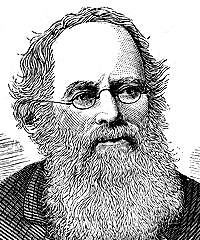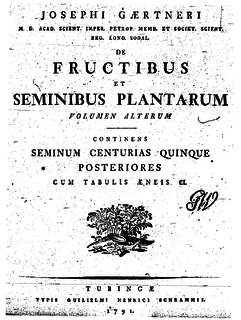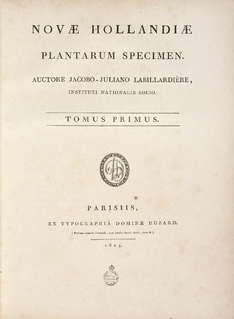Related Research Articles

Admiral Arthur Phillip was a British Royal Navy officer who served as the first governor of the Colony of New South Wales.

Sir Joseph Banks, 1st Baronet, was an English naturalist, botanist, and patron of the natural sciences.

Allan Cunningham was an English botanist and explorer, primarily known for his travels in Australia to collect plants.

Daniel Carlsson Solander or Daniel Charles Solander was a Swedish naturalist and an apostle of Carl Linnaeus. Solander was the first university-educated scientist to set foot on Australian soil.

Allelopathy is a biological phenomenon by which an organism produces one or more biochemicals that influence the germination, growth, survival, and reproduction of other organisms. These biochemicals are known as allelochemicals and can have beneficial or detrimental effects on the target organisms and the community. Allelopathy is often used narrowly to describe chemically-mediated competition between plants, however, it is sometimes defined more broadly as chemically-mediated competition between any type of organisms. Allelochemicals are a subset of secondary metabolites, which are not directly required for metabolism of the allelopathic organism.
George Caley was an English botanist and explorer, active in Australia for the majority of his career.

Colonel William Paterson, FRS was a Scottish soldier, explorer, Lieutenant Governor and botanist best known for leading early settlement at Port Dalrymple in Tasmania. In 1795, Paterson gave an order that resulted in the massacre of a number of men, women and children, members of the Bediagal tribe.

Sydney Parkinson was a Scottish botanical illustrator and natural history artist. He was the first European artist to visit Australia, New Zealand and Tahiti. Parkinson was the first Quaker to visit New Zealand. The standard author abbreviation Parkinson is used to indicate this person as the author when citing a botanical name.

Jacques-Julien Houtou de Labillardière was a French biologist noted for his descriptions of the flora of Australia. Labillardière was a member of a voyage in search of the La Pérouse expedition. He published a popular account of his journey and produced the first Flora on the region.

The Honourable Sir William Macarthur was an Australian botanist and vigneron. He was one of the most active and influential horticulturists in Australia in the mid-to-late 19th century. Among the first viticulturists in Australia, Macarthur was a medal-winning wine-maker, as well as a respected amateur botanist and noted plant breeder.

De Fructibus et Seminibus Plantarum, also known by its standard botanical abbreviation Fruct. Sem. Pl., is a three-volume botanic treatise by Joseph Gaertner. The first volume was published in December 1788. The second volume was published in four parts, in 1790, 1791, 1791 and 1792 respectively. A third volume was published after Gaertner's death by his son Karl Friedrich von Gaertner from 1805 to 1807; this final volume is also known as 'Supplementum Carpologicae', abbreviated as Suppl. Carp.. Most of the illustrations for the work were done by Johann Georg Sturm (1742-1793).
James Squire, alternatively known as James Squires, was a First Fleet convict transported to Australia. Squire is credited with the first successful cultivation of hops in Australia around the start of the 19th century. First officially brewing beer in Australia in 1790; James later founded Australia's first commercial brewery making beer using barley and hops in 1798, although John Boston appears to have opened a brewery making a form of corn beer two years earlier.
George Maxwell (1804–1880) was a professional collector of plants and insects in Southwest Australia. The botanical specimens he obtained were used to make formal descriptions of the region's plant species.

The flora of Western Australia comprises 10,551 published native vascular plant species and a further 1,131 unpublished species. They occur within 1,543 genera from 211 families; there are also 1,317 naturalised alien or invasive plant species more commonly known as weeds. There are an estimated 150,000 cryptogam species or nonvascular plants which include lichens, and fungi although only 1,786 species have been published, with 948 algae and 672 lichen the majority.

Novae Hollandiae Plantarum Specimen is a two-volume work describing the flora of Australia. Facsimiles of the originals can be found in the online Biodiversity Heritage Library (Vol.1) and Vol 2).

Thomas Watling, was an early Australian painter and illustrator, notable for his natural history drawings and landscapes.

Félix Delahaye was a French gardener who served on the Bruni d'Entrecasteaux voyage (1791–93) that was sent by the French National Assembly to search for the missing explorer Jean-François La Perouse. He was also one of the earliest European gardeners to work in Australia.
Daniel Moowattin (c1791-1816) was an Aboriginal Australian Darug man from the Parramatta area in New South Wales. He is noted for his work as a guide and assistant to the botanical collector George Caley and as the third Aboriginal person known to have visited England. There are a number of other spellings of his name, including Mow-watty, Mowwatting, Moowatting and Moowattye.

Thomas Dancer was a British physician and colonial botanist.

Dr Robert Townson MD FRSE LLD (1762–1827) was an English natural historian and traveller, known also a mineralogist and medical man. In 1806 he emigrated to New South Wales.
References
- 1 2 3 Gray, A. J. (1966). "Burton, David ( - 1792)". Australian Dictionary of Biography . Melbourne University Press. ISSN 1833-7538 . Retrieved 2009-05-12– via National Centre of Biography, Australian National University.
- ↑ Willis, Rick (2007). The History of Allelopathy. p. 113.
- ↑ Quattrocchi, Umberto. CRC world dictionary of plant names. CRC Press. p. 378.